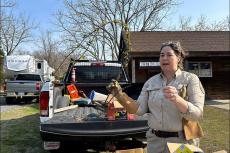Attorneys for oceanfront property owners along what is popularly known as Truck Beach on Napeague have convinced a New York State Supreme Court judge to move the trespassing violations of 14 East Hampton Town residents from the town justice court to the Suffolk County Supreme Court.
The move follows an Oct. 17 protest at the 4,000-foot stretch of beach that a State Supreme Court Appellate Division panel decided in February is owned to the mean high water mark by upland property owners. In that action, commercial fishermen and their supporters drove their trucks across the beach and upon their return were issued summonses for trespassing. It was an act of civil disobedience similar to an earlier action in June, when fishermen and others protested the privatization of a beach that had been used for fishing and recreation for generations.
A hearing in justice court was to happen yesterday. But an order to show cause signed last Thursday by Supreme Court Justice Paul Baisley Jr. on behalf of the property owners states that the 14 defendants must instead appear in his court on Nov. 29 to show cause as to why the court should not remove the summonses from East Hampton Town Justice Court.
The order refers to Stephen Angel and James Catterson, attorneys for the homeowners. Also named as defendants are the town trustees, who own and manage many of the town’s beaches on behalf of the public, and the town board. Also last Thursday, Christopher McDonald, an attorney representing the town, wrote to Justice Baisley urging him to decline the plaintiffs’ request for an order to show cause.
“I can only describe this as the absolute height of bullying tactics,” Dan Rodgers, an attorney representing some of the fishermen, said on Saturday. On Tuesday, he spoke further about the plaintiffs’ move. “What they’re doing is just outrageous, crazy, unprecedented,” he said.
The Appellate Division panel’s Feb. 3 ruling overturned a 2016 Supreme Court decision that found that an 1882 deed in which the town trustees conveyed some 1,000 acres on Napeague to Arthur Benson reserved rights — including some public use — to town residents. It was followed by a June 4 injunction reiterating the Appellate Division panel’s decision. This summer signs and barriers were erected prohibiting vehicle access.
The New York State Court of Appeals in September rejected requests by the town and the trustees to reconsider the February ruling. That seemed to bring an end to litigation dating to 2009, when several property owners associations brought lawsuits against the town and the trustees claiming that the chains of title to their respective properties extended to the mean high-water mark of the ocean per the 1882 deed.
But that deed “reserved to the inhabitants of the Town of East Hampton the right to land fish boats and netts [sic] to spread the netts [sic] on the adjacent sands and care for the fish and material as has been customary heretofore on the South Shore of the Town lying westerly of these conveyed premises.”
“Now,” Mr. Rodgers said, “my clients are missing seasonal opportunities to earn a living. They’re nervous about going on that beach. . . . The issue is clear: There is a property right, an easement. It doesn’t matter who owns the beach.”
The fishermen were making a point with their Oct. 17 action, Mr. Rodgers said, and had hoped the matter would make it to court.
The upland property owners “have no standing,” Mr. Rodgers said on Tuesday. “If you look at the violation complaints filed in court, nowhere do you see any homeowner’s name, or the president of any homeowners association.” The summonses were written by town police against residents, he said. “The homeowners are not party to this criminal action. They have no standing to challenge it.”




